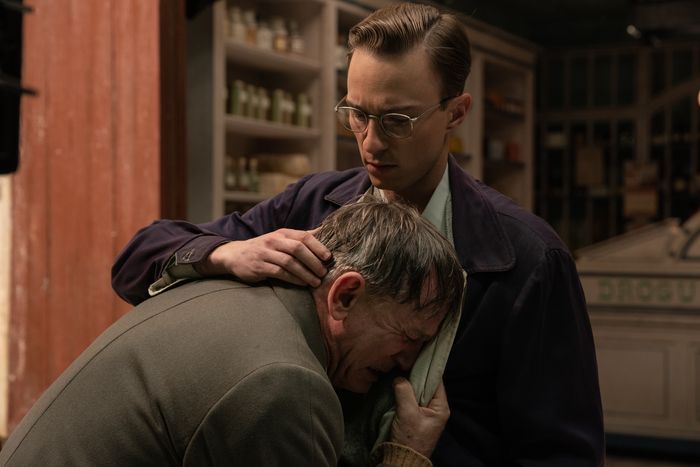
“Guys, let’s be adults in the room for one second,” Luca Guadagnino sighed midway through the Venice press conference for Queer. An Australian journalist had just asked if there would ever be a gay James Bond, prompting a theatrical shrug from Guadagnino. “Nobody will ever know James Bond’s desires,” he deadpanned. “The important thing is that he does his missions properly.”
Until the day we see a James Bond who knows what Boiler Room is, Queer might have to suffice. An adaptation of the semi-autobiographical William S. Burroughs novel, the movie stars Daniel Craig as Lee, a lonely expat in 1950s Mexico obsessed with a young hunk (Drew Starkey) who may or may not return his affections. Ahead of the film’s Venice premiere, Guadagnino had called its sex scenes “numerous and quite scandalous,” and this was not false advertising: They are notably more explicit than those in Brokeback Mountain or Guadagnino’s own Call Me by Your Name. (Translated: There are multiple instances of male full-frontal nudity, though not from Craig.)
In the press conference, Guadagnino hailed the “generosity” of his leading man: “Very few iconic actors allow their fragility to be seen.” This vulnerability is evident not just in the fact that in Queer, the former James Bond is playing a bisexual heroin addict. In an even bigger stretch, he’s also someone you wouldn’t want to get caught next to at a party — the least charismatic character Craig has ever played onscreen. Lee is awkward, exhausting, and painfully insecure. After sex, he can’t stop himself from asking his partner, “Do you not mind this terribly?” (The response is hardly reassuring: “Not terribly.”) He’s down so bad that music from the ’50s cannot contain him; only through the power of Nirvana can we truly comprehend his horniness.
Queer’s bevy of love scenes are not just an occasion to admire the physiques of Craig and Starkey — though they are that, as well — they also function as a handy corrective for any young person wondering how a sex scene could ever advance the plot. In his fleeting hookups, it’s clear that Lee is well used to giving pleasure. Witness his surprise at finally receiving it, and you can understand why he throws so much of himself at the younger man.
The film climaxes with a trip to Ecuador, where Lee seeks a plant — yage, otherwise known as ayahuasca — that he believes will give him telepathic powers. (Yes, this tender gay love story shares key plot similarities with Madame Web.) Without spoiling too much, the jungle becomes the backdrop for a wordless dance, the two men getting to know each other under the skin. As Craig and Starkey explained, the months of rehearsals for this sequence helped prepare them for the nude acrobatics to come.
“Dancing with someone is a great icebreaker,” Craig said. “There’s nothing intimate about filming a sex scene on a movie set. We just wanted to make it as touching, real, and natural as we possibly could. We had a laugh, you know? We made it fun.”
“We felt open to try new things,” Starkey added. “When you’re rolling around on the floor with someone the second day, that’s a good way to get to know someone.”
Last week, Queer was acquired by A24, who are expected to mount a Best Actor campaign for Craig. (Though matters may be complicated by the fact that the studio already has a significant contender in Sing Sing’s Colman Domingo.) Awards wise, the star may have a leg up from the fact that he is essentially playing William S. Burroughs, whose sexuality was not widely known before the publication of Queer in 1985. Craig said he prepared for the role by watching old interviews of the author. “He had this persona — very deep, measured — and I thought, That can’t be him. Or it’s only part of him. It may be a defense.” Reading the book unlocked the private side of Burroughs. “It is about love, but it’s about loss, it’s about loneliness, it’s about yearning.”
The result was not just the most human-scaled performance Craig has given in some time. (Among other things, Queer features his finest glasses acting since Girl With the Dragon Tattoo.) Burroughs wrote the book when the events it was based on were still fresh, and hid it away in shame for 30 years. The film is in many ways a time capsule of queer life in the ’50s: the self-loathing, the cliques, even the fashion. As costume designer J.W. Anderson noted, every single item of clothing in the movie was authentic vintage from the period. As much as the sex scenes, it was this fact that proved the biggest hurdle for the star.
“I couldn’t spill coffee,” Craig said.
More From the Lido
- Julianne Moore and Tilda Swinton Are Perfectly Imperfect Together
- A Minute-By-Minute Breakdown of The Brutalist
- The Brutalist Is Half Of A Great Movie


